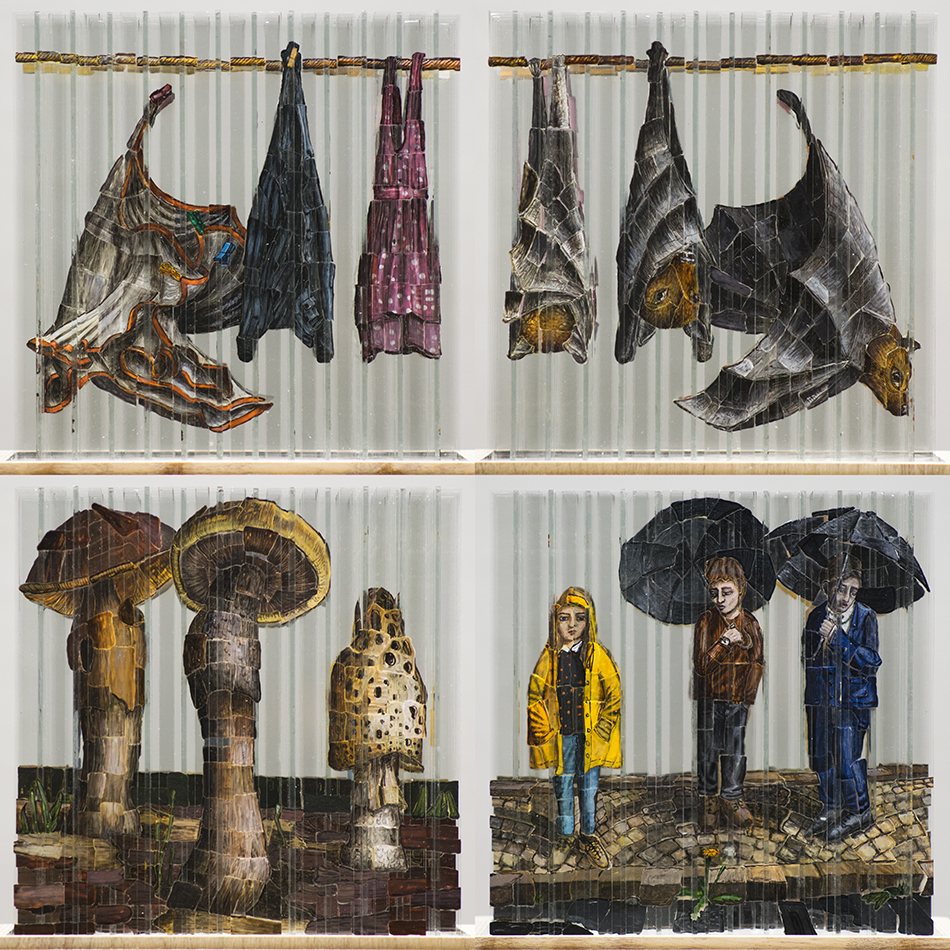Menu
The New Contemporary Art Magazine


The illusionary works of Thomas Medicus include "What It Is Like to Be," an anamorphic sculpture consisting of 144 hand-painted strips of glass that reveal new images when turned. Each of the strips were painted separate from another, and specifically, the new images are revealed when the piece is turned 90 degrees.

Carrying a mystical undercurrent, Chie Shimizu’s sculptures are rooted in an exploration of "the significance of human existence.” The artist, born in Japan and based now in Queens, New York, has crafted these riveting figures over the past couple decades, moving between different scales and textural approaches.
 The solitary figurative sculptures of Frode Bolhuis are untethered to any one specific culture or frame of mind, existing at the convergence of generations and experiences. His use of textiles brings a more visceral connections to each of the subjects, and the vibrancy within each extends past the artist’s chosen hues.
The solitary figurative sculptures of Frode Bolhuis are untethered to any one specific culture or frame of mind, existing at the convergence of generations and experiences. His use of textiles brings a more visceral connections to each of the subjects, and the vibrancy within each extends past the artist’s chosen hues. In the hands of KT Beans, a seashell takes on unsettling qualities. The sculptor says she creates "oddities for humans of the future”: Teeth, eyes, and other human body parts and organs emerge out of unexpected places.
In the hands of KT Beans, a seashell takes on unsettling qualities. The sculptor says she creates "oddities for humans of the future”: Teeth, eyes, and other human body parts and organs emerge out of unexpected places. Masayoshi Hanawa’s intricate ceramic and resin creatures are pulled from the artist’s internal mythology. His creations are filled with mosaic-like detail, each corner of a monster a meticulously crafted and vibrant pattern.
Masayoshi Hanawa’s intricate ceramic and resin creatures are pulled from the artist’s internal mythology. His creations are filled with mosaic-like detail, each corner of a monster a meticulously crafted and vibrant pattern. Brian Tolle's startling sculptures are said to be a dialogue between "history and context." His ability to manipulate what appear to be the most stubborn of structures is more than just a clever use of materials such as styrofoam and urethane (as is th case in the top piece, "Eureka.") Tolle forces us to consider our own relationship with the materials around us.
Brian Tolle's startling sculptures are said to be a dialogue between "history and context." His ability to manipulate what appear to be the most stubborn of structures is more than just a clever use of materials such as styrofoam and urethane (as is th case in the top piece, "Eureka.") Tolle forces us to consider our own relationship with the materials around us. Hirofumi Fujiwara’s isolated sculptures are called Utopians, each person actually an amalgamation of features and cultures. Many of these characters, said to be from a parallel world, are presented inside of barriers as they “bear witness.”
Hirofumi Fujiwara’s isolated sculptures are called Utopians, each person actually an amalgamation of features and cultures. Many of these characters, said to be from a parallel world, are presented inside of barriers as they “bear witness.” The remixed and altered porcelain sculptures of ceramicist Penny Byrne often have a political edge. Byrne's methods recall the methods of Barnaby Barford and the late Click Mort. She uses enamel paints, epoxy resin, putty, and other materials to evolve these found statues.
The remixed and altered porcelain sculptures of ceramicist Penny Byrne often have a political edge. Byrne's methods recall the methods of Barnaby Barford and the late Click Mort. She uses enamel paints, epoxy resin, putty, and other materials to evolve these found statues. In Amy Brener's "Omni-Kit" sculpture series, everyday objects and imagery are reprocessed into totem-like sculptures that speak to ritual and memory. These works are highlighted in a new show at Jack Barrett Gallery titled "Consolarium," a word the artist created for the place where these objects and figures across time collide into these single objects. Materials include urethane resin and foam, silicone, pigment, and more. The show runs through Dec. 20.
In Amy Brener's "Omni-Kit" sculpture series, everyday objects and imagery are reprocessed into totem-like sculptures that speak to ritual and memory. These works are highlighted in a new show at Jack Barrett Gallery titled "Consolarium," a word the artist created for the place where these objects and figures across time collide into these single objects. Materials include urethane resin and foam, silicone, pigment, and more. The show runs through Dec. 20. CrocodilePOWER is a Moscow-based duo who craft dystopic yet vibrant installations, sculptures, and paintings. Consisting of artists Peter Goloshchapov and Oksana Simatova, the pair works in materials like fiberglass, porcelain, wood, moss, iron, and more. See some of their recent, startling visions below.
CrocodilePOWER is a Moscow-based duo who craft dystopic yet vibrant installations, sculptures, and paintings. Consisting of artists Peter Goloshchapov and Oksana Simatova, the pair works in materials like fiberglass, porcelain, wood, moss, iron, and more. See some of their recent, startling visions below.